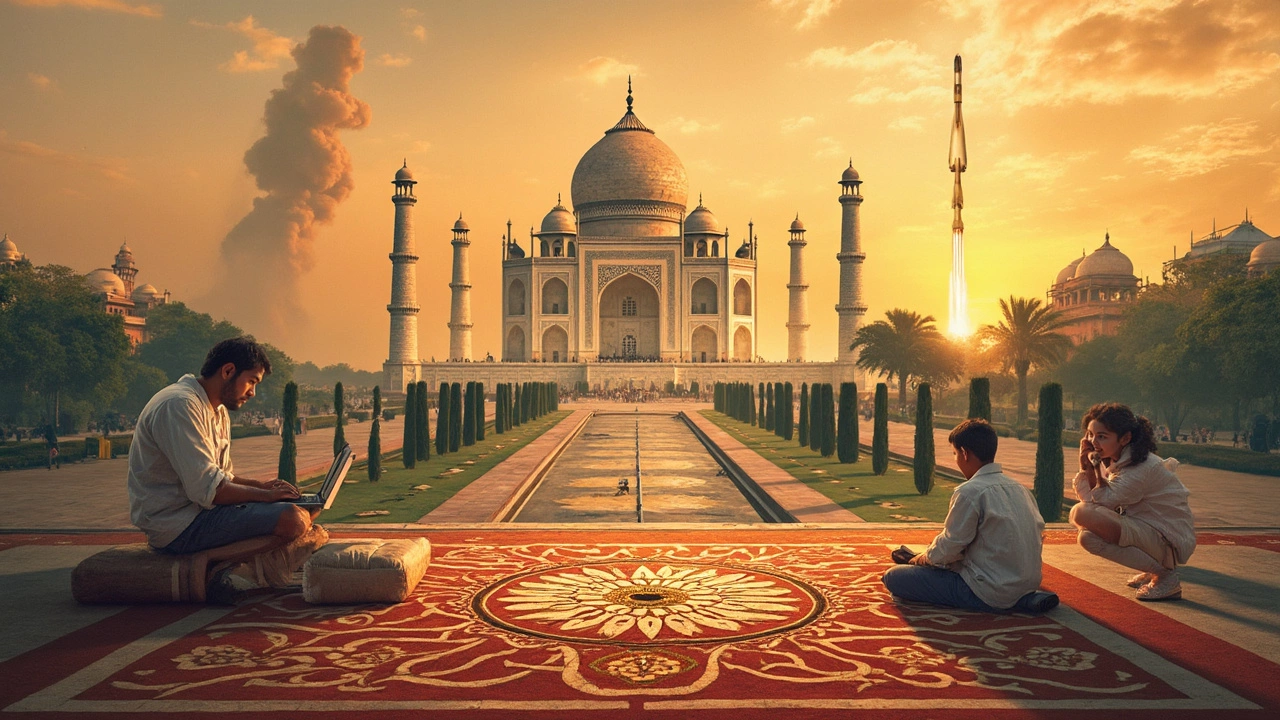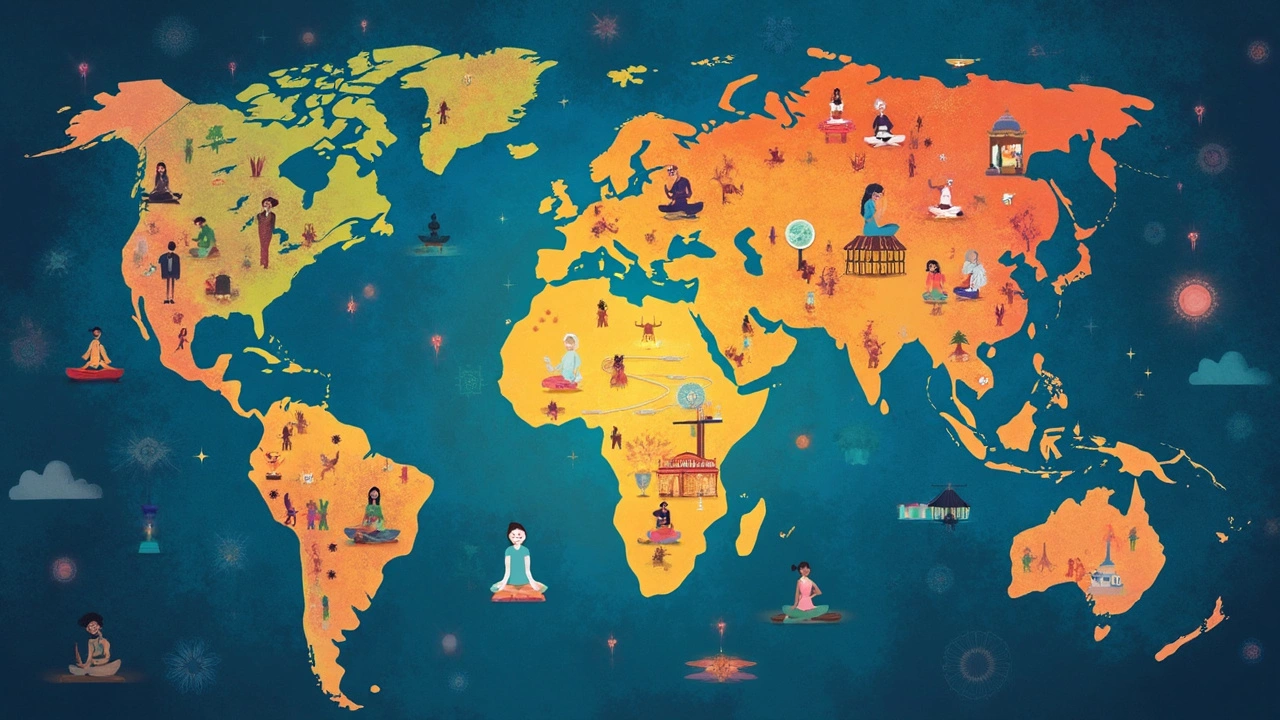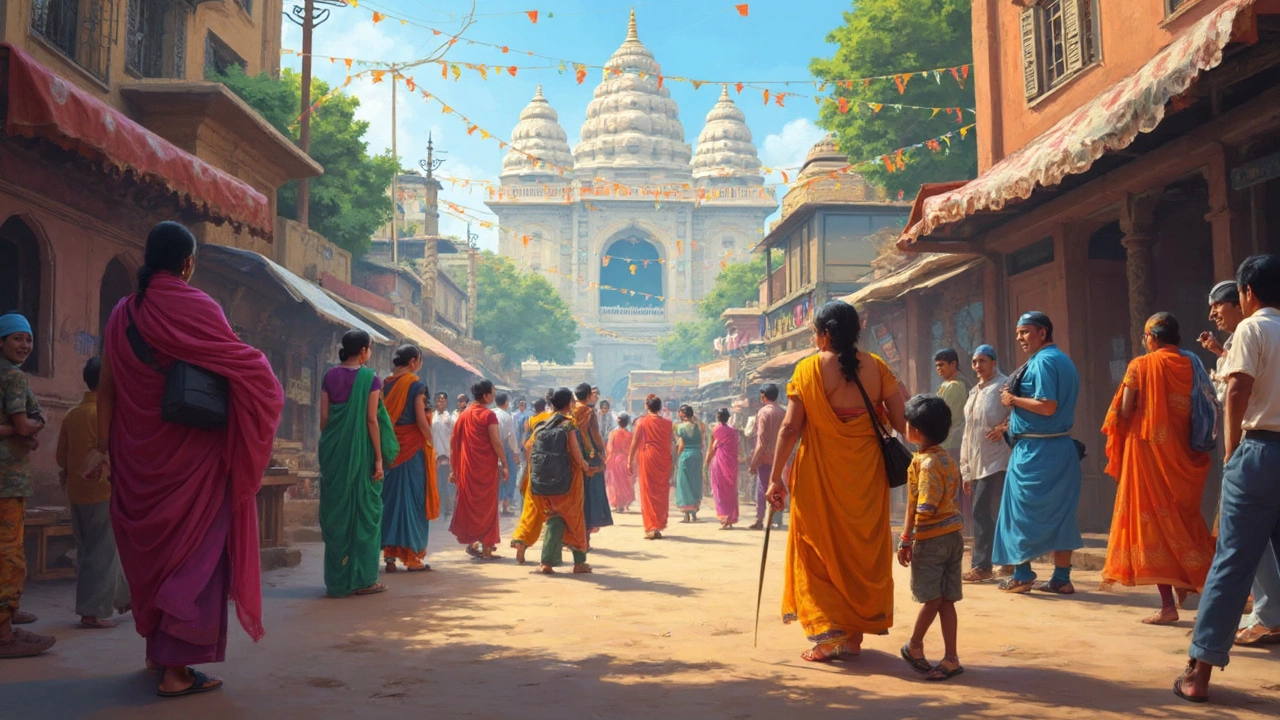There’s a reason you find bits of India everywhere—from spices in your kitchen, to an Indian IT expert fixing your tech, to yoga studios in every corner of the globe. India isn’t just a country; it’s a living, breathing celebration of old wisdom and new hustle. People love to talk about India’s diversity, but honestly, it blows your mind when you see it in action. No two states are quite the same, the food changes every few hundred kilometers, and so do the festivals and languages. You could walk down a street in Chennai and hear Tamil being spoken, only to get on a train and step out in Punjab and suddenly it's all about Punjabi. Sounds a bit wild? That’s Indian identity: a million different tunes somehow playing in harmony.
The Obsession with Indian Heritage: Ancient Roots, Modern Glow
India isn’t just old; it’s ancient. We’re talking about civilizations from 2500 BCE. The Indus Valley dudes were using indoor plumbing before most parts of Europe even knew what soap was. Here’s a fun fact: the game of chess? Born in India, originally called ‘Chaturanga.’ Algebra and the concept of zero? Also invented in India. Those old Sanskrit texts on yoga and meditation—undo stress in Silicon Valley and ashrams in Rishikesh, basically the same moves.
Walk into any Indian city and you’ll spot temples, mosques, churches, gurudwaras, and Buddhist stupas—all sharing the skyline. The country is dotted with UNESCO World Heritage Sites, from Taj Mahal’s marble romance to the mind-boggling ancient stepwells of Rajasthan. Even Bollywood loves to shoot historical epics that’ll give Hollywood costume designers a run for their money.
People often overlook that India’s ancient roots don’t make it stuck in the past. Sanskrit shlokas and classical dance rub shoulders with hip-hop in Mumbai and street art in Bengaluru. Heritage here isn’t something tucked away in museums. It's lived every day, celebrated in morning rituals, rooftop kite-flying, epic street festivals, and grandmother stories passed down at dinnertime.
Diversity Like Nowhere Else: Languages, Faiths, and Flavors
If you ever struggle to decide what to order at an Indian restaurant, imagine living there—India’s got over 1,600 spoken languages and more than two dozen official ones. It’s like a chatroom with people switching languages mid-conversation. Hindi, Bengali, Telugu, Marathi, Tamil, Urdu—the list goes on, and paperwork in India is printed in at least 22 languages.
Religion? India’s the birthplace of Hinduism, Buddhism, Jainism, and Sikhism, and is home to one of the world’s largest Muslim and Christian populations. On almost every major holiday, streets get splashed with colors, light, and music. If you hear loud banging drums in March, it’s probably Holi. Full streets of decorated lamps in October? That’s Diwali, with fireworks, sweets, and everyone greeting each other with “Happy Diwali!” even if they belong to another faith.
Food is where it gets even wilder. Think about it: Butter chicken came from Punjab, dosas from Tamil Nadu, idli-sambar from Kerala, momos from the northeast, and rosogolla from the east—all on one table in most Indian homes. Taste a Gujarati thali one day, and you’ll wonder how sugar can taste this good. Try Goan fish curry, and you’ll swear you’re on a beach even if you’re far from one.
- India has the most vegetarians of any country—around 30% of its population.
- The Kumbh Mela festival is the largest human gathering on Earth—over 55 million people in 2013.
- Mumbai’s dabbawalas, who deliver food boxes, boast a 99.99% accuracy rate. Even Harvard studied them!

Innovation, Tech Boom, and Startups: India on the Global Stage
It’s easy to picture India as all spices and traditions, but let’s talk about how the country is running toward the future. India is the world’s top software exporter, and companies like Infosys, TCS, and Wipro are household names in the tech world. By 2025, India’s digital economy is set to reach $1 trillion, which is no small feat. Here’s something neat: over 40% of all digital payment transactions worldwide happen in India. No, that’s not a typo—people are sending money with a phone swipe, even in remote villages.
Startups? India has over 100 unicorns (companies valued at $1 billion or more). Big cities like Bengaluru, Hyderabad, and Pune have turned into hubs where teens with laptops and coffee take on Silicon Valley. Practically every Indian you meet has an ‘idea’ that could be the next big thing, and it’s not just talk. Edutech (like Byju’s), fintech (Paytm), and even space tech (ISRO, anyone?) are examples of this homegrown hustle.
India’s success stories are also astronauts like Rakesh Sharma and tech bosses like Sundar Pichai or Satya Nadella, who run companies that shape your online life. If you’re using Google, Teams, ChatGPT, or shopping on Amazon, you’re interacting with stuff created by Indian brains at the top. India sent a mission to Mars, ‘Mangalyaan,’ on a shoestring budget—and it worked on the first try, unlike even NASA or the Europeans. Beat that for value for money.
| Company | Year Founded | Sector | Current Valuation ($ Billion) |
|---|---|---|---|
| Flipkart | 2007 | E-commerce | 37.6 |
| Byju’s | 2011 | Edutech | 22 |
| Ola | 2010 | Mobility | 6.5 |
| Paytm | 2010 | Fintech | 4.2 |
Cultural Powerhouses: Sports, Movies, and Global Influence
Ever seen an Indian cricket match day? It’s not just a game—it’s a national holiday, even when it’s not. Sachin, Dhoni, Virat—kids in every corner of the country want to be these legends. The Indian Premier League (IPL) is among the top-earning sports leagues in the world, drawing players from Australia, England, South Africa—pretty much everywhere cricket is played. But it’s not only cricket. India brought home its highest ever medal haul at the Tokyo Olympics—seven medals, with Neeraj Chopra earning the country its first ever Olympic gold in javelin.
Then there’s Bollywood, which isn’t so much a film industry as a cultural storm. India produces over 2,000 films a year in several languages—way more than Hollywood. Ever heard the beats of “Jai Ho” from Slumdog Millionaire? Or seen Priyanka Chopra, Deepika Padukone, or Irrfan Khan gracing the world stage? Indian music, dance, and even fashion have their own fan clubs from Nigeria to New York. People in Nigeria remake Bollywood hits, while K-pop stars are trying Indian dance moves for TikTok.
Actually, let’s talk about Indian soft power. You’ll find Indian doctors running hospitals in the Middle East, desi engineers powering American tech, yoga retreats in Peru, and Bollywood blockbusters airing in Russia. Indian food—curry, naan, samosas—is so global that Chicken Tikka Masala is basically Britain’s national dish now. And don’t be surprised if you see a “Namaste” greeting at airports anywhere from Sydney to San Francisco. That’s Indian culture working magic far beyond its borders.
- With 50 million fans, Virat Kohli is the most-followed Asian athlete on Instagram.
- India’s Diwali festival is celebrated in over 30 countries worldwide, from Canada to Australia.
- The Indian diaspora is the largest in the world, with over 18 million people living abroad.

Tips for Experiencing the Real India: What Makes It Special?
If you actually want to get under India’s skin and see what all the pride is about, start by saying yes to every kind of food (ask if it’s spicy before you bite in—trust me). The best way to travel is on a train, where chai-sellers, snack vendors, and grandparents will all talk to you before your journey ends. Don’t just snap photos of the Taj Mahal. Peek into a local market, join in a temple procession, or knock on the door for homemade food. Most importantly: talk to people, because the stories are as delicious as the food.
Maybe hit a cricket gully match, or learn a few Bollywood dance steps by just copying the neighbor’s kids. If you’re lucky enough to be around during Holi, brace yourself—it’s a wild free-for-all of color, song, and hugs. Yoga and Ayurveda might sound like “Instagram trends” elsewhere, but in India, real people still practice these every morning. Local crafts? Grab a handloom saree or a pair of jootis from Rajasthan, and you’re carrying a piece of living history that tells a story better than any souvenir mug.
Folks in India have a knack for finding joy in the little things—from street-side tea stalls to singing on trains, from jostling at a local fair to leaning in for political debates at a roadside shop. The pride isn’t about showing off; it's about sharing warmth, resilience, laughter, and that unbeatable feeling of belonging to a community that’s always got a story to tell.
Want to understand why India is our pride? Don’t check a guidebook—walk into the chaos, eat with your hands, chat with strangers, share a laugh under the monsoon rains. That’s where India’s real heart—and pride—lives.
